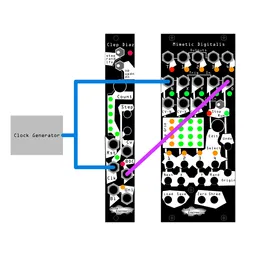Reverb is generally used as a way of simulating space in a mix. However, its capabilities go far beyond that: in my patches I use it as a way to shape the timbre of a sound as much as I use it for simulating rooms. Today, let’s talk about how reverb can completely change a sound with some simple patching and clever modulation.
The concept: shape the ‘verb
This is a technique that’ll work with any reverb that can have its feedback amount modulated, and it’s worth trying with any reverb you have, hardware or software.
If we run a sound through some reverb without modulation, it’ll just sound like we put it in a new space. Traditional reverbs create echoes that trick our brain into thinking that sounds are different distances away in different types of environments. Here, I’ll use Desmodus Versio since it responds nicely to CV, and I like the tonal variations I can get out of it. Desmodus goes beyond that simple concept and allows for a lot of experimentation (infinite verb, anyone?), but it’s still just reverb. By changing its Regen parameter, or the feedback parameter on any other reverb you might be using, you can change the length of the echoes.
Learn more:
The patch
Set the Regen on Desmodus to minimum and send in a sound: there’s basically no reverb, even with a high Blend setting. But as we start to turn Regen up, we get more and more reverb. If we turn it back down, that reverb decays much more quickly than it would if we left it alone. This means that by CV controlling the Regen parameter, we have dynamic and almost instantaneous control of the reverb tail. So, if we have a voice, like the Cursus Iteritas Percido, we can patch the envelope that controls the dynamics of that voice into the Regen parameter on Desmodus and get a reverb that follows the dynamics of our voice. Instead of sounding like normal reverb, it sounds like a new layer on top of our input sound.
Now, we need to get a tiny bit more complicated here before this patch will work. If we send the CIP’s envelope directly to Regen, it’ll sweep the whole value of the parameter. The issue here is that at the top end of the Regen parameter, Desmodus ducks the reverb based on the input signal. We can get around this by attenuating down our envelope slightly, so that at its highest point, Regen is just below the point it’d start ducking.
Then, all we need to do is patch the Cursus audio out to the Desmodus’s input, patch its outputs to our mixer, and we have a patch!
This patch gives us a really organic control of the reverb portion of the sound, since we’re controlling its decay time instead of its volume. This is a really subtle difference, but it sounds a lot more natural, as you can hear:
This technique is great for emulating strings and brass: if you create the patch above using a simple saw wave as the input, you’ll get a pretty convincing tuba out.
If you make a cool patch using the techniques we talked about today, we want to hear it! Tag us in your Instagram patches, or send us an email.






